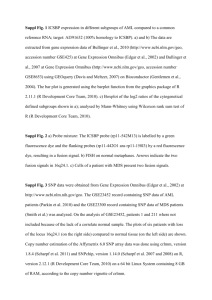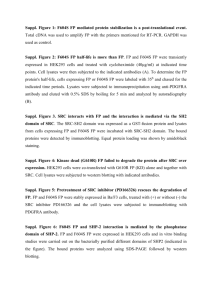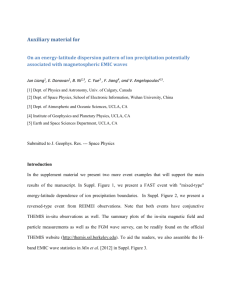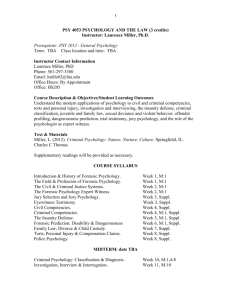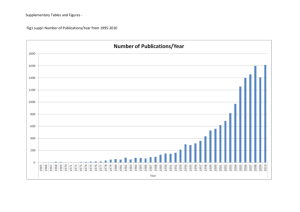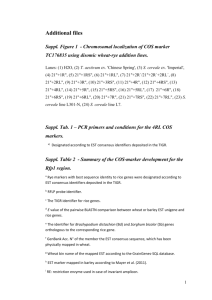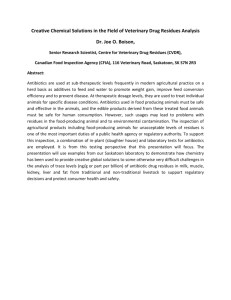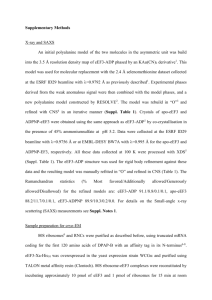Prediction of Disordered Regions in Proteins from
advertisement
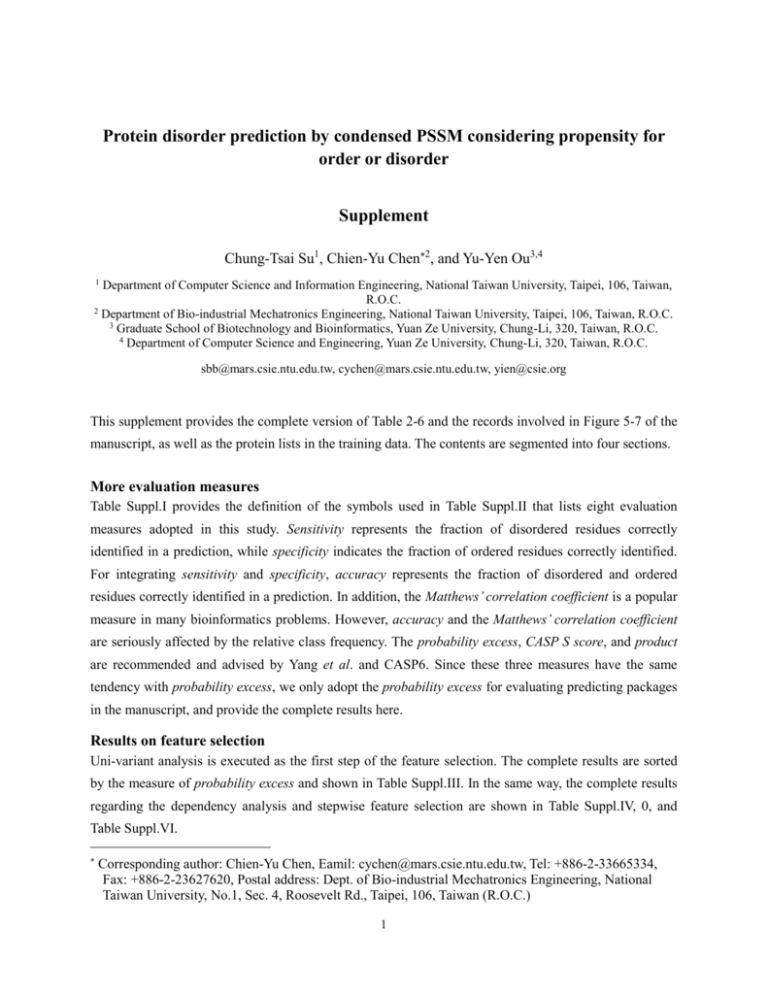
Protein disorder prediction by condensed PSSM considering propensity for order or disorder Supplement Chung-Tsai Su1, Chien-Yu Chen2, and Yu-Yen Ou3,4 1 Department of Computer Science and Information Engineering, National Taiwan University, Taipei, 106, Taiwan, R.O.C. 2 Department of Bio-industrial Mechatronics Engineering, National Taiwan University, Taipei, 106, Taiwan, R.O.C. 3 Graduate School of Biotechnology and Bioinformatics, Yuan Ze University, Chung-Li, 320, Taiwan, R.O.C. 4 Department of Computer Science and Engineering, Yuan Ze University, Chung-Li, 320, Taiwan, R.O.C. sbb@mars.csie.ntu.edu.tw, cychen@mars.csie.ntu.edu.tw, yien@csie.org This supplement provides the complete version of Table 2-6 and the records involved in Figure 5-7 of the manuscript, as well as the protein lists in the training data. The contents are segmented into four sections. More evaluation measures Table Suppl.I provides the definition of the symbols used in Table Suppl.II that lists eight evaluation measures adopted in this study. Sensitivity represents the fraction of disordered residues correctly identified in a prediction, while specificity indicates the fraction of ordered residues correctly identified. For integrating sensitivity and specificity, accuracy represents the fraction of disordered and ordered residues correctly identified in a prediction. In addition, the Matthews’ correlation coefficient is a popular measure in many bioinformatics problems. However, accuracy and the Matthews’ correlation coefficient are seriously affected by the relative class frequency. The probability excess, CASP S score, and product are recommended and advised by Yang et al. and CASP6. Since these three measures have the same tendency with probability excess, we only adopt the probability excess for evaluating predicting packages in the manuscript, and provide the complete results here. Results on feature selection Uni-variant analysis is executed as the first step of the feature selection. The complete results are sorted by the measure of probability excess and shown in Table Suppl.III. In the same way, the complete results regarding the dependency analysis and stepwise feature selection are shown in Table Suppl.IV, 0, and Table Suppl.VI. Corresponding author: Chien-Yu Chen, Eamil: cychen@mars.csie.ntu.edu.tw, Tel: +886-2-33665334, Fax: +886-2-23627620, Postal address: Dept. of Bio-industrial Mechatronics Engineering, National Taiwan University, No.1, Sec. 4, Roosevelt Rd., Taipei, 106, Taiwan (R.O.C.) 1 Results on testing data In comparison with other methods, DisPSSMP performs the best in the first blind testing dataset when the three measures CASP S score, produce, and probability excess are concerned, as shown in Table Suppl.VII. Meanwhile, DisPSSMP gets the second rank on the second blind testing dataset as shown in Table Suppl.VIII. The overall results on the blind testing data are organized in Table Suppl.IX. Protein lists of training datasets At the end of this document, we provide the entry name of each protein in the training datasets PDB693 and D184 in Table Suppl.X and Table Suppl.XI, respectively. Table Suppl.I. The symbols used in Table Suppl.II Name Acronym Description True positive TP The number of correctly classified disordered residues False positive FP The number of ordered residues incorrectly classified as disordered True negative TN The number of correctly classified ordered residues False negative FN The number of disordered residues incorrectly classified as ordered Weight of TP wTP The number of ordered residues divided by the total number of residues Weight of FP wFP Weight of TN wTN Weight of FN wFN - wTN The number of disordered residues divided by the total number of residues - wTP Table Suppl.II. The equations of evaluation measures (the complete version of Table 2) Measure Abbreviation Equality Sensitivity (Recall) Sens. TP/(TP+FN) Specificity Spec. TN/(TN+FP) Precision Prec. TP/(TP+FP) Accuracy Accu. (TP+TN)/(TP+FP+TN+FN) MCC (TPTN-FPFN)/sqrt((TP+FP)(TN+FN)(TP+FN)(TN+FP)) Matthews' correlation coefficient (wTPTP+wFPFP+wTNTN+wFNFN)/( wTP (TP +FN)+ wTN (TN CAPS S Score Product Probability excess CASP S Prod. +FP)) (TPTN)/((TP+FN)(TN+FP)) Prob. Excess (TPTN-FPFN)/((TP+FN)(TN+FP)) 2 Table Suppl.III. The performance of each amino acid property by uni-variant analysis (the complete version of Table 3) Property TP FP TN FN Sens. Spec. Prec. Accu. MCC CASP S Prod. Prob. Excess Hydrophobic 50506 72749 184352 29273 0.633 0.717 0.410 0.697 0.309 12.66 0.454 0.350 HydrophobicO 51081 64086 193015 28698 0.640 0.751 0.444 0.725 0.350 14.13 0.481 0.391 HydrophobicD 41370 71288 185813 38409 0.519 0.723 0.367 0.674 0.217 8.72 0.375 0.241 Polar 49124 68400 188701 30655 0.616 0.734 0.418 0.706 0.312 12.64 0.452 0.350 PolarO 48126 76463 180638 31653 0.603 0.703 0.386 0.679 0.269 11.06 0.424 0.306 PolarD 48178 69036 188065 31601 0.604 0.731 0.411 0.701 0.299 12.12 0.442 0.335 Small 44130 66278 190823 35649 0.553 0.742 0.400 0.697 0.268 10.68 0.411 0.295 SmallO 44295 80194 176907 35484 0.555 0.688 0.356 0.657 0.214 8.79 0.382 0.243 SmallD 46215 62019 195082 33564 0.579 0.759 0.427 0.716 0.308 12.22 0.440 0.338 Aliphatic 47909 64785 192316 31870 0.601 0.748 0.425 0.713 0.314 12.60 0.449 0.349 Aromatic 48224 71983 185118 31555 0.604 0.720 0.401 0.693 0.288 11.73 0.435 0.324 AromaticO 48010 68911 188190 31769 0.602 0.732 0.411 0.701 0.298 12.06 0.440 0.334 AromaticD 42893 87398 169703 36886 0.538 0.660 0.329 0.631 0.173 7.15 0.355 0.198 Positive 47750 82703 174398 32029 0.599 0.678 0.366 0.659 0.242 10.01 0.406 0.277 PositiveO 45686 86823 170278 34093 0.573 0.662 0.345 0.641 0.204 8.49 0.379 0.235 PositiveD 46546 85724 171377 33233 0.583 0.667 0.352 0.647 0.218 9.04 0.389 0.250 Negative 46754 78102 178999 33025 0.586 0.696 0.374 0.670 0.248 10.20 0.408 0.282 Proline 44964 81124 175977 34815 0.564 0.684 0.357 0.656 0.218 8.97 0.386 0.248 Charged 48966 75459 181642 30813 0.614 0.707 0.394 0.685 0.282 11.58 0.434 0.320 ChargedO 45547 86450 170651 34232 0.571 0.664 0.345 0.642 0.204 8.48 0.379 0.235 ChargedD 48096 75644 181457 31683 0.603 0.706 0.389 0.681 0.272 11.16 0.425 0.309 Tiny 42103 69031 188070 37676 0.528 0.732 0.379 0.683 0.234 9.37 0.386 0.259 TinyO 46014 83549 173552 33765 0.577 0.675 0.355 0.652 0.220 9.10 0.389 0.252 TinyD 44087 64694 192407 35692 0.553 0.748 0.405 0.702 0.274 10.88 0.414 0.301 The best performance among each property group is highlighted with bold font. 3 Table Suppl.IV. The comparison between properties Hydrophobic, Aliphatic, and Aromatic (the complete version of Table 4) Prob. Property TP FP TN FN Sens. Spec. Prec. Accu. MCC CASP S Prod. Excess HydrophobicO 51081 64086 193015 28698 0.640 0.751 0.444 0.725 0.350 14.13 0.481 0.391 Aliphatic 47909 64785 192316 31870 0.601 0.748 0.425 0.713 0.314 12.60 0.449 0.349 AromaticO 48010 68911 188190 31769 0.602 0.732 0.411 0.701 0.298 12.06 0.440 0.334 51463 59752 197349 28316 0.645 0.768 0.463 0.739 0.373 14.92 0.495 0.413 Aliphatic + AromaticO The best performance is highlighted with bold font. Table Suppl.V. The comparison between Polar, Positive, and Negative (the complete version of Table 5) Prob. Property TP FP TN FN Sens. Spec. Prec. Accu. MCC CASP S Prod. Excess Polar 49124 68400 188701 30655 0.616 0.734 0.418 0.706 0.312 12.64 0.452 0.350 Positive 47750 82703 174398 32029 0.599 0.678 0.366 0.659 0.242 10.01 0.406 0.277 Negative 46754 78102 178999 33025 0.586 0.696 0.374 0.670 0.248 10.20 0.408 0.282 48386 73372 183729 31393 0.607 0.715 0.397 0.689 0.284 11.61 0.433 0.321 Positive + Negative The best performance is highlighted with bold font. Table Suppl.VI. Results of the stepwise feature selection (the complete version of Table 6) Prob. Property TP FP TN FN Sens. Spec. Prec. Accu. MCC CASP S Prod. Excess 0.49 Aliphatic+AromaticO 51507 59998 197103 28272 0.646 0.767 0.462 0.738 0.372 14.90 5 0.412 0.50 Aliphatic+AromaticO+Polar 52353 58076 199025 27426 0.656 0.774 0.474 0.746 0.390 15.55 Aliphatic+AromaticO+Polar +SmallD 8 0.430 0.51 52328 56309 200792 27451 0.656 0.781 0.482 0.751 0.397 15.79 2 0.437 52036 55847 201254 27743 0.652 0.783 0.482 0.752 0.396 15.72 0.511 0.435 Aliphatic+AromaticO+Polar +SmallD+Proline The best performance is highlighted with bold font. 4 Table Suppl.VII. Comparing the performance of thirteen packages predicting protein disorder on the testing dataset R80. (the complete results of Figure 5) Method TP FP TN FN Sens. Spec. Prec. Accu. MCC CASP S Prod. Prob. Excess DisPSSMP 2800 4550 25359 849 0.767 0.848 0.381 0.839 0.463 0.119 0.651 0.615 RONN 2200 3634 26275 1449 0.603 0.878 0.377 0.849 0.395 0.093 0.530 0.481 IUPred(short) 1887 1642 28267 1762 0.517 0.945 0.535 0.899 0.469 0.090 0.489 0.462 DISpro 1525 209 29700 2124 0.418 0.993 0.879 0.930 0.578 0.080 0.415 0.411 IUPred(long) 1591 1179 28730 2058 0.436 0.961 0.574 0.904 0.449 0.077 0.419 0.397 DISOPRED2* 1432 734 25890 2104 0.405 0.972 0.661 0.906 0.470 0.078 0.394 0.377 PONDR 2033 5518 24391 1616 0.557 0.816 0.269 0.787 0.278 0.072 0.454 0.373 DisEMBL(hot) 1795 4788 25121 1854 0.492 0.840 0.273 0.802 0.260 0.064 0.413 0.332 DisEMBL(465) 1217 564 29345 2432 0.334 0.981 0.683 0.911 0.437 0.061 0.327 0.315 FoldIndex 1782 5664 24245 1867 0.488 0.811 0.239 0.776 0.224 0.058 0.396 0.299 PreLink 863 1597 28312 2786 0.237 0.947 0.351 0.869 0.219 0.035 0.224 0.183 GlobPlot 1357 5654 24255 2292 0.372 0.811 0.194 0.763 0.140 0.035 0.302 0.183 0.032 0.314 0.165 DisEMBL(coils) 2702 17222 12687 947 0.740 0.424 0.136 0.459 0.104 *For DISOPRED2, the public web server has a sequence length limit of 1000 residues; therefore, 1HN0, 1FO4, and 1PS3 in R80 cannot be predicted. 5 Table Suppl.VIII. Comparing the performance of thirteen packages predicting protein disorder on the testing datasets U79 and P80. (the complete results of Figure 6) Method TP FP TN FN Sens. Spec. Prec. Accu. MCC CASP S Prod. Prob. Excess IUPred(long) 9807 963 15605 4655 0.678 0.942 0.911 0.819 0.650 0.309 0.639 0.620 DisPSSMP 11934 3896 12672 2528 0.825 0.765 0.754 0.793 0.589 0.294 0.631 0.590 RONN 9763 1854 14714 4699 0.675 0.888 0.840 0.789 0.580 0.280 0.600 0.563 FoldIndex 10439 3071 13497 4023 0.722 0.815 0.773 0.771 0.540 0.267 0.588 0.536 IUPred(short) 8047 1406 15162 6415 0.556 0.915 0.851 0.748 0.511 0.235 0.509 0.472 DISPRED2* 5921 318 16250 6714 0.469 0.981 0.949 0.759 0.543 0.221 0.460 0.449 PONDR 9139 3611 12957 5323 0.632 0.782 0.717 0.712 0.420 0.206 0.494 0.414 DISpro 5540 292 16276 8922 0.383 0.982 0.950 0.703 0.467 0.182 0.376 0.365 DisEMBL(465) 5039 359 16209 9423 0.348 0.978 0.933 0.685 0.430 0.163 0.341 0.327 PreLink 4608 141 16427 9854 0.319 0.991 0.970 0.678 0.430 0.154 0.316 0.310 DisEMBL(hot) 7263 4159 12409 7199 0.502 0.749 0.636 0.634 0.260 0.125 0.376 0.251 DisEMBL(coils) 10398 9182 7386 4064 0.719 0.446 0.531 0.573 0.170 0.082 0.321 0.165 GlobPlot 4461 2970 13598 10001 0.308 0.821 0.600 0.582 0.151 0.064 0.253 0.129 *For DISOPRED2, the public web server has a sequence length limit of 1000 residues; therefore, the u15 protein in U79 cannot be predicted. 6 Table Suppl.IX. Comparing the performance of thirteen packages predicting protein disorder on the testing datasets R80, U79, and P80. (the complete results of Figure 7) Method TP FP TN FN Sens. Spec. Prec. Accu. MCC CASP S Prod. Prob. Excess DisPSSMP 14734 8446 38031 3377 0.814 0.818 0.636 0.817 0.592 0.255 0.666 0.632 IUPred(long) 11398 2142 44335 6713 0.629 0.954 0.842 0.863 0.644 0.235 0.600 0.583 RONN 11963 5488 40989 6148 0.661 0.882 0.686 0.820 0.549 0.219 0.583 0.542 FoldIndex 12221 8735 37742 5890 0.675 0.812 0.583 0.774 0.467 0.196 0.548 0.487 IUPred(short) 9934 3048 43429 8177 0.549 0.934 0.765 0.826 0.541 0.195 0.513 0.483 DISOPRED2* 7353 1052 42140 8818 0.455 0.976 0.875 0.834 0.550 0.171 0.444 0.430 PONDR 11172 9129 37348 6939 0.617 0.804 0.550 0.751 0.407 0.170 0.496 0.420 DISpro 7065 501 45976 11046 0.390 0.989 0.934 0.821 0.530 0.153 0.386 0.379 DisEMBL(465) 6256 923 45554 11855 0.345 0.980 0.871 0.802 0.465 0.131 0.339 0.326 DisEMBL(hot) 9058 8947 37530 9053 0.500 0.807 0.503 0.721 0.308 0.124 0.404 0.308 PreLink 5471 1738 44739 12640 0.302 0.963 0.759 0.777 0.378 0.107 0.291 0.265 5011 0.723 0.432 0.332 0.514 0.143 0.063 0.312 0.155 8624 37853 12293 0.321 0.814 0.403 0.676 0.146 0.055 0.262 0.136 DisEMBL(coils) GlobPlot 13100 26404 20073 5818 *For DISOPRED2, the public web server has a sequence length limit of 1000 residues; therefore, 1HN0, 1FO4, and 1PS3 in R80 and the u15 protein in U79 cannot be predicted. 7 Table Suppl.X. The list of the proteins in the training dataset PDB693 PDB693 16VPA 1FFTB 1JFIB 1NG0A 1QQ0A 1TMO 1XLXA 1A0OB 1FGJA 1JHFB 1NHZA 1QQGA 1TOAA 1XMAA 1A22B 1FHGA 1JIIA 1NJ1A 1QS1A 1TOLA 1XMJA 1A36A 1FIWA 1JJ2G 1NKTA 1QVHH 1TQQA 1XMRA 1A37A 1FJGC 1JK0A 1NKWE 1QWYA 1TT0A 1XOUA 1A5LC 1FJMA 1JK0B 1NKWF 1QX7D 1TTWB 1XQEA 1A81E 1FKAD 1JKFA 1NKWN 1QY6A 1TVLA 1XRFA 1AGQA 1FKAR 1JKGB 1NLZC 1QYUA 1TWYA 1XRJA 1AGRE 1FKMA 1JM6A 1NMBN 1QZ2A 1TXNA 1XRSB 1AL0B 1FNTU 1JMAB 1NO1A 1QZ7B 1TYQC 1XTEA 1AL3 1FQYA 1JMAA 1NOVA 1R0VA 1U04A 1XVIA 1AMUA 1FS9A 1JMJA 1NRGA 1R27B 1U0RB 1XVLA 1AMX 1FSTA 1JMUB 1NRIA 1R30A 1U2JA 1XWSA 1AO7D 1FUUA 1JNK 1NT9D 1R52A 1U4FA 1XZQA 1AROP 1FXZA 1JPHA 1NW1A 1R5MA 1U67A 1Y08A 1ATIA 1G0UM 1JQOA 1NW3A 1R6TB 1U6GC 1Y10A 1AUIA 1G3JC 1JQPA 1NYHA 1R71A 1U78A 1Y1OA 1B34A 1G5GA 1JSQA 1NZEA 1R7RA 1U7FB 1Y44A 1B3OA 1G5RA 1JSWC 1O4ZA 1RDR 1U9IC 1Y4SA 1B70A 1G6IA 1JV2B 1O5DL 1REWC 1U9OA 1Y6AA 1B89A 1G8EB 1JXQA 1O5DT 1RGQA 1UA2A 1Y80A 1B8MB 1G9RA 1K3VA 1O5LA 1RI1A 1UD0D 1Y8QB 1B9XC 1G9UA 1K3ZD 1O6OD 1RIID 1UE1A 1YA0A 1BB9 1GCYA 1K5DB 1O91A 1RJGA 1UF2A 1YAEF 1BCCB 1GD2J 1K5DC 1O94D 1RJKA 1UF2K 1YBXA 1BE3I 1GIYE 1K6IA 1OATA 1RJMA 1UIJC 1YBYA 1BG1A 1GJVA 1K78I 1OD2A 1RK8A 1UL1Y 1YC1A 1BGW 1GK9A 1K87A 1OD5A 1RLUA 1UN0C 1YCSB 1BGYE 1GMEB 1K8KB 1OE9A 1RO8B 1UNGD 1YD7A 1BI2B 1GMNB 1KCXA 1OEDA 1RQEA 1URSB 1YDHB 1BIF 1GRH 1KGNA 1OEDB 1RQGA 1US7B 1YEWC 1BIIA 1GV4A 1KKTA 1OEDC 1RV2A 1UTBA 1YGUA 8 Table Suppl.X. (Continued) The list of the proteins in the training dataset PDB693 PDB693 1BMFG 1GW5A 1KMIZ 1OEDE 1RXTA 1V02A 1YISA 1BMP 1GZ0E 1KMMA 1OF5A 1RY6A 1V0DA 1YJ5C 1BO1A 1GZHD 1KMOA 1OF5B 1RY7B 1V5WA 1YM7A 1C5KA 1H0NA 1KO6A 1OFTA 1RYFA 1V8DA 1YMMD 1C8BA 1H2AS 1KO6B 1OHFA 1RZ2A 1V8JA 1YMYB 1C8DA 1H2DA 1KOHB 1OHHH 1RZNA 1V98A 1YNUA 1C8M4 1H2VZ 1KOQA 1OHTA 1S1EA 1V9DC 1YOXD 1C8NA 1H3NA 1KPLA 1OIUC 1S1ID 1V9YA 1YQ7A 1CBF 1H4TB 1KT0A 1OJLB 1S1IN 1VCRA 1YR2A 1CD1A 1H6KB 1KTKF 1OLZA 1S1IW 1VDDC 1YTFC 1CHUA 1H6WA 1KWPA 1ONFA 1S1IX 1VDZA 1YTVM 1CJKC 1H76A 1KXF 1OPLA 1S1IY 1VE5C 1YTZI 1CJMA 1H7UA 1KY9A 1OPOA 1S21A 1VF7A 1YU6C 1CJYA 1H89C 1KZQA 1ORHA 1S2JA 1VFGA 1YVGA 1CLC 1H8EH 1L0OC 1OT3A 1S3RA 1VH3A 1YWHA 1CLWA 1HBXG 1L3AA 1OT8B 1S3SI 1VH6A 1Z05A 1CO7I 1HCNB 1L5HA 1OU5A 1S4EG 1VHKD 1Z4VA 1CP3A 1HFES 1L8AA 1OVLA 1S5JA 1VK5A 1Z5VA 1CT9A 1HK7A 1L8KA 1OW3A 1S5LC 1VKYA 1Z5XE 1CWPA 1HNKA 1L8WA 1OXNA 1S72I 1VL5C 1Z6KA 1D2HA 1HU3A 1L9BM 1P4DA 1S72Y 1VLRA 1Z6UA 1D2MA 1HVUG 1L9ZH 1P5JA 1S78A 1VP3 1Z7DC 1D2QA 1HVXA 1LAJA 1P5SA 1S80A 1VPGA 1Z81A 1D9XA 1HW4A 1LARB 1P6FA 1S94A 1VQUB 1Z92B 1DAR 1HYNP 1LAY 1P6GF 1S9HC 1VR9A 1Z9FA 1DD7A 1HYQA 1LBD 1P6GN 1S9IB 1VRDA 1ZCUA 1DEQA 1HZFA 1LBHA 1P7BA 1SCFA 1VRWA 1ZE2B 1DF0A 1HZTA 1LD4M 1P85B 1SE8A 1VYHC 1ZIWA 1DGSA 1I0IA 1LI5A 1P85C 1SERA 1VYVA 1ZNNA 1DIOB 1I2MA 1LOX 1P85F 1SEVA 1VZOA 1ZTMA 1DIOG 1I3QA 1LSHA 1P85J 1SG2B 1W1OA 1ZTPC 1DKGA 1I3QC 1LSHB 1P85O 1SGJA 1W1WA 1ZXEB 1DKIA 1I3QF 1LTLA 1P8CA 1SHKB 1W1WE 1ZY9A 9 Table Suppl.X. (Continued) The list of the proteins in the training dataset PDB693 PDB693 1DLYA 1I41A 1LTXR 1P99A 1SHSA 1W2B5 2A11A 1DMGA 1I4OC 1LUFA 1P9EA 1SJNA 1W36D 2A1TA 1DP5B 1I7DA 1LW3A 1PF4A 1SJPA 1W36F 2A33B 1DPI 1I7FA 1M0FF 1PJAA 1SMVA 1W46A 2A3LA 1DVEA 1I84S 1M0UA 1PJR 1SO2A 1W6UC 2A3QA 1DZLA 1I8NA 1M1HA 1PK8A 1SP9A 1W7PD 2A79B 1E1HA 1I94M 1M2VB 1PKYC 1SQ1A 1W81A 2BBVA 1E3HA 1IBJA 1M41A 1PME 1SQBA 1W8XP 2BHVA 1E5RA 1ID3D 1M6BA 1POV1 1SR4A 1W9PA 2BIVA 1E94E 1IIPA 1M9SA 1PQ4A 1SR9A 1WAWA 2BJUA 1E9NA 1IK6A 1MB1 1PQVS 1SRQD 1WB1B 2BKIA 1EEPA 1IK7A 1MCXA 1PSCA 1SVCP 1WDJB 2BNXA 1EFM 1IKOP 1MEYG 1PSDB 1SW6A 1WK2A 2BOVB 1EG2A 1IR6A 1MG7A 1PU4A 1SXJA 1WM9A 2BP1A 1EH7A 1IS7A 1MH5B 1PVOB 1SY6A 1WNCA 2BTOA 1EI3A 1IVOA 1MHPY 1PWPB 1SZIA 1WP1B 2BTVA 1EI3B 1IW7A 1ML5E 1PZDA 1SZWA 1WV4A 2CAUA 1EJ6B 1IW7D 1MNNA 1PZNA 1T10A 1X6VB 2CSMA 1EQQA 1IXRA 1MQ8A 1PZSA 1T3EP 1X7UA 2GNKA 1EW2A 1IYJB 1MQBA 1Q0CA 1T3JA 1X9DA 2IG2H 1EWRA 1IZLA 1MQLB 1Q14A 1T4HB 1X9NA 2PF1 1EYSC 1IZLB 1MQSA 1Q1CA 1T4OA 1X9PA 2PRGC 1EZXC 1IZLD 1MU7A 1Q1LA 1T5AA 1XA6A 2TBVA 1F0XA 1IZLE 1MVFD 1Q1SC 1T6PB 1XARA 2TS1 1F15A 1J3IA 1MVMA 1Q32A 1T7LA 1XDIA 4HB1 1F1JA 1J9YA 1N0HA 1Q3DA 1T94B 1XDTR 4SBVA 1F1OA 1JA0B 1N0YA 1Q55A 1T9GR 1XFVA 5CRXB 1F2NA 1JB7A 1N3LA 1Q67A 1TBGB 1XHOC 7CEIB 1F66A 1JB7B 1N4KA 1Q8IA 1TDHA 1XI8A 1F66D 1JBQA 1N6DA 1QAXB 1TEDB 1XIOA 1F7CA 1JC9A 1N7DA 1QB3A 1TF2A 1XJ5A 1F8VB 1JCHA 1N93X 1QBZB 1TG6A 1XJDA 1FCBB 1JCQA 1N9EA 1QE0B 1TH1C 1XK8A 10 Table Suppl.X. (Continued) The list of the proteins in the training dataset PDB693 PDB693 1FCHA 1JDPA 1NAEA 1QHUA 1TLLB 1XKKA 1FFTA 1JEQA 1NFUB 1QMEA 1TME4 1XKSA Table Suppl.XI. The list of the proteins in the training dataset D184 D184 DP00001 DP00031 DP00065 DP00098 DP00142 DP00175 DP00217 DP00002 DP00032 DP00066 DP00100 DP00143 DP00177 DP00218 DP00003 DP00033 DP00067 DP00102 DP00144 DP00179 DP00219 DP00004 DP00034 DP00068 DP00103 DP00145 DP00180 DP00221 DP00005 DP00036 DP00069 DP00108 DP00146 DP00181 DP00222 DP00006 DP00038 DP00070 DP00109 DP00147 DP00182 DP00223 DP00007 DP00039 DP00071 DP00110 DP00148 DP00184 DP00224 DP00008 DP00040 DP00072 DP00112 DP00149 DP00190 DP00225 DP00010 DP00041 DP00075 DP00113 DP00150 DP00191 DP00227 DP00011 DP00042 DP00076 DP00116 DP00151 DP00192 DP00228 DP00012 DP00044 DP00077 DP00117 DP00152 DP00193 DP00229 DP00013 DP00045 DP00078 DP00118 DP00154 DP00197 DP00230 DP00014 DP00046 DP00080 DP00119 DP00155 DP00198 DP00232 DP00015 DP00048 DP00082 DP00120 DP00156 DP00199 DP00233 DP00016 DP00049 DP00083 DP00121 DP00157 DP00201 DP00234 DP00017 DP00050 DP00084 DP00124 DP00158 DP00203 DP00235 DP00018 DP00052 DP00085 DP00125 DP00159 DP00205 DP00236 DP00019 DP00053 DP00087 DP00126 DP00160 DP00206 DP00238 DP00021 DP00054 DP00088 DP00127 DP00161 DP00207 DP00239 DP00022 DP00056 DP00089 DP00128 DP00162 DP00208 DP00240 DP00024 DP00057 DP00090 DP00130 DP00163 DP00209 DP00241 DP00025 DP00058 DP00091 DP00132 DP00164 DP00210 DP00242 DP00026 DP00059 DP00092 DP00136 DP00167 DP00211 DP00027 DP00061 DP00093 DP00137 DP00169 DP00213 DP00028 DP00062 DP00094 DP00138 DP00171 DP00214 DP00029 DP00063 DP00095 DP00140 DP00173 DP00215 11
